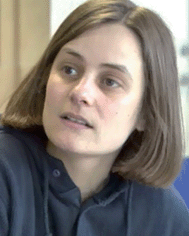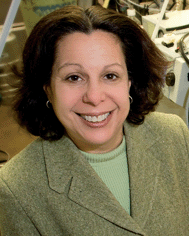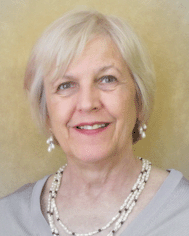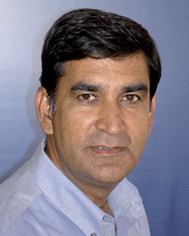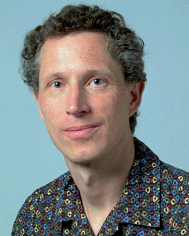DOI: 10.1039/C1EM90023D
(Profile)
J. Environ. Monit., 2011, 13, 1132-1134
Contributors to the Environmental Nanotechnology themed issue
Lars Duester
Lars Duester was born in Germany, in 1973. He received his PhD in Chemistry from the University of Duisburg-Essen, Germany in 2007. In 2008 he joined the Institute of Environmental- and Soil-Chemistry at the University of Koblenz-Landau as a scientific assistant. At the end of 2010 he joined the Federal Institute of Hydrology, research group: Aquatic Chemistry in Germany. His current research interests are the fate of metal(loid)s in surface waters – either released on a natural basis or from anthropogenic causes. Examples are the border zone between particles/colloids to dissolved species or the transformation of inorganic/organic metal(loid) species.
Teresa Fernandes
Teresa Fernandes has just moved to Heriot-Watt University, Edinburgh, where she is a Professor of Environmental Science. Previously she spent 17 years at Edinburgh Napier University where she was the Director of the Centre for Environment and Marine Sciences. Her research has focused on contaminants in natural systems and their effects on species and communities. She is particularly interested in ecosystem health, links with human health, and management of risk. Another important aspect of her research is the management of aquatic and coastal systems, and the integration of science and policy for the sustainable management of natural systems.
Birgit Gaiser
Birgit Gaiser was born in Germany, in 1979. She received her PhD in toxicology from the University of Edinburgh (UK) in 2008, and graduated (biochemistry) from the Eberhard-Karls-Universität Tübingen (Germany) in 2004. In 2007, she joined Edinburgh Napier University as a post-doctoral research fellow in nanotoxicology and ecotoxicology. Since 2011, she has been employed as a post-doctoral research fellow at Heriot-Watt University (UK). Her current interest include the toxicology of nanoparticles and the development of alternative or in vitro methods for risk assessment.
Fadri Gottschalk
Fadri Gottschalk is a postdoctoral researcher in the “Environmental Risk Assessment and Management” group at Empa, the Swiss Federal Laboratories for Materials Science and Technology, and lecturer in Game and Decision Theory at ETH Zürich. He obtained an MSc (University Hagen) and a PhD in environmental sciences (ETH Zürich). His research is mainly focused on computer-based quantitative exposure and fate modeling of anthropogenic pollutants (engineered nanomaterials) in the environment. Currently the focus of attention of his work is on stochastic formalization and computational programming approaches to deal with parametric and conceptual uncertainties in environmental exposure modeling.
Vicki Grassian
Vicki H. Grassian is currently an F. Wendell Miller Professor of Chemistry at the University of Iowa. Her research interests are in the areas of heterogeneous chemistry of mineral dust aerosol, environmental molecular surface science, and environmental and health aspects of nanoscience and nanotechnology. She has nearly 200 peer-reviewed publications, 15 book chapters and is the editor of 3 books including Nanoscience and Nanotechnology: Environmental and Health Impacts. In 2005, she became a Fellow of the American Association for the Advancement of Science and, in 2010, she was named Fellow of the Royal Society of Chemistry and the American Vacuum Society.
Barbara Karn
Barbara Karn is a scientist at EPA in nanotechnology and the environment. She holds a PhD in marine ecology, a masters degree in limnology and a bachelors degree in chemistry. Dr Karn was named one of the Top Ten Experts in nanotechnology EHS by Nanotechnology Law and Business. She is senior advisor to the project on Emerging Nanotechnologies at the Woodrow Wilson Center focusing on “Green” nanotechnologies. She also served as the Nanotechnology Scholar for Georgetown's Program on Science in the Public Interest and visiting scientist at the University of South Carolina.
Rai Kookana
Rai Kookana was born in India. He received his PhD in Soil Science from the University of Western Australia in 1989. In 1992 he joined CSIRO Australia as a research scientist. Currently, as a Principal Research Scientist, he is leading a research team focussing on chemistry and ecotoxicology of environmental contaminants in terrestrial and aquatic environments. His current research interests include fate and effects of emerging contaminants, such as pharmaceuticals, personal care products and synthetic nanoparticles in the environment.
Robert MacCuspie
Robert I. MacCuspie is a research chemist in the Nanomechanical Properties Group at the National Institute of Standards and Technology. He holds a PhD in Nanotechnology and Materials Chemistry from The Graduate Center of the City University of New York, and a BS in Chemistry and a BS in Molecular & Microbiology from the University of Central Florida. Prior to joining NIST, he was an NRC post-doctoral fellow at the Air Force Research Laboratory. His research focuses on measuring, understanding and controlling nanoparticle surfaces, especially interfaces with biologically and environmentally relevant conditions.
Ndeke Musee
Ndeke Musee is a Senior Researcher at the Council for Scientific and Industrial Research (CSIR) in Pretoria. He holds a PhD in Chemical Engineering Science from Stellenbosch University, and is a scientific leader credited for initiating Nanotechnology Risk Assessment in South Africa since 2007. He is a Technical Committee member of ISO TTC 229 on nanomaterial risk assessment in South Africa, and a member of the National Nanotechnology Health, Safety and Environment Advisory Committee constituted by DST. Ndeke is currently working on several research projects towards understanding the risks of engineered nanomaterials in the environment.
Bernd Nowack
Bernd Nowack is leader of the “Environmental Risk Assessment and Management” group at Empa, the Swiss Federal Laboratories for Materials Science and Technology. He obtained an MSc and a PhD in environmental sciences from ETH Zürich. His general interest is to study anthropogenic pollutants in the environment and their interactions with biota. His research bridges between the development of analytical techniques, laboratory investigations, field studies, and modeling. His current research is focused mainly on engineered nanomaterials, and he is working on qualitative risk assessment, quantitative exposure modeling, release of nanomaterials from products and their behavior and effects in the environment.
Wunmi Sadik
Wunmi Sadik is a Professor of Chemistry at the State University of New York at Binghamton (SUNY-Binghamton). She is the Director of the Center for Advanced Sensors and Environmental Systems. Professor Sadik received her PhD in Chemistry from the University of Wollongong in Australia and did postdoctoral research at the US Environmental Protection Agency (US-EPA) in Las Vegas, Nevada. She has held previous appointments at Harvard University, Cornell University and Naval Research Laboratories in Washington, DC. Her research currently centers on the interfacial molecular recognition processes, sensors and biomaterials, and immunochemistry with tandem instrumental techniques. Professor Sadik is the recipient of Harvard University's Distinguished Radcliffe Fellowship, National Science Foundation's Discovery Corps Senior Fellowship, SUNY Chancellor Award for Research, Chancellor Award for Outstanding Inventor, and National Research Council COBASE fellowship.
Vicki Stone
Vicki Stone is Director of the Nano Safety research group at Heriot-Watt University, Edinburgh, Director of Toxicology for SAFENANO (http://www.safenano.org/), and Editor-in-chief of the journal Nanotoxicology (http://informahealthcare.com/nan). Vicki has published over 100 publications pertaining to particle toxicology over the last 13 years. Collaborations span Europe, the USA and Asia. Vicki worked previously at Edinburgh Napier University (1996–2010, postdoc, lecturer, senior lecturer, reader and then professor), University of Birmingham (1995–1996, postdoc), Pasteur Institute (1994–1995, postdoc) and University of Birmingham (1991–1994, PhD).
Ming Wang
Ming K. Wang is currently a distinguished professor, Department of Agricultural Chemistry and Life Sciences at National Taiwan University. His research interests include separation and identification of environmental nanoparticles by TEM, NMR, synchrotron XRD, FT-IR, etc.
Paul Westerhoff
Paul Westerhoff is a Professor in the School of Sustainable Engineering and The Built Environment at Arizona State University (Tempe, AZ). He has garnered wide recognition for his work related to treatment and occurrence of emerging contaminants in water (trace organics, disinfection by-products, nanomaterials and others). He currently is a member of the US-EPA Science Advisory Board – environmental engineering committee, Vice Chair – WateReuse Foundation Research Advisory Board, and External Advisory Board member for CEINt. Professor Westerhoff received the 2005 ASCE Walter L. Huber Research Award, 2006 WEF Paul L. Busch Award and recently became a Senior Sustainability Scientist – Global Institute of Sustainability at ASU.
| This journal is © The Royal Society of Chemistry 2011 |


